This July and August, we’re celebrating the release of Star Trek Beyond by taking a look back at the third season of the original Star Trek. Check back every Monday, Wednesday and Friday for the latest update.
Like Is There in Truth No Beauty? before it, The Empath is very much “weird big ideas” version of Star Trek.
It is a simple story, as Kirk and his away team visit a planet in a star system about to go nova. It deals with fairly universal themes, like compassion and humanity. There are stakes, there are aliens, there is a test of worthiness. In many ways, The Empath is a quintessential Star Trek episode, one of those classic “humanity proves their worth to a powerful alien species” narratives in the style of Arena or Spectre of the Gun. The biggest deviation from that template is the fact that it is not humanity on trial; it is an unknown species represented by an anonymous mute.

The triumvirate triumphant.
However, The Empath works in large part due to this simplicity. There is an elegance to the story, one that distils a lot of core Star Trek ideals down to their very essence. The Empath is very much a “humans are special” story, in the vein of episodes like Lonely Among Us or The Last Outpost. However, it works better than most of these stories because it hits on a very strong core idea. The Empath suggests that what makes humanity special is not necessarily unique or intrinsic or intangible. According to The Empath, what makes humanity special is pretty basic.
As the title implies, humanity’s greatest virtue might be its empathy or its compassion.
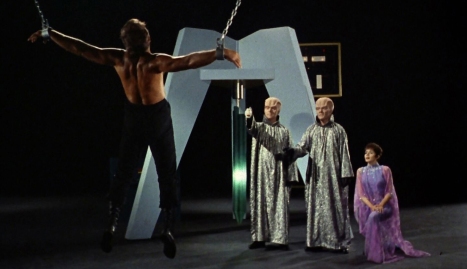
Although humanity also offers “Shirtless Shat.”
The Empath works in large part due to its elegance and its simplicity. The set-up is fairly simple, established through the exposition of the opening log entry. The Minara star is entering a “critical period” of its “nova phase.” The Enterprise has been ordered to evacuate a research facility before the star goes nova and consumes everything in the system. When the Enterprise picks up a “gigantic solar flare”, it is forced to withdraw to a safe distance. Kirk and his party are left alone on the surface of the planet.
Inevitably, Kirk discovers that the researchers are not where they are supposed to be. Instead, they have been abducted by an alien species. Kirk and his away team are abducted by the same aliens, and subjected to a battery of brutal tests while an anonymous alien mute watches silently. Kirk finds himself wrestling with impossible questions of sacrifice and compassion as the sinister alien overseers confront him with one difficult choice after another. Lives hang in the balance, as the nature of the test slowly becomes clear.
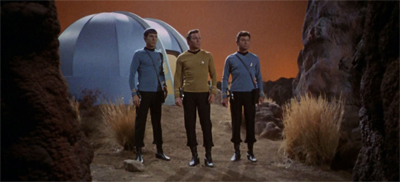
Researching the research party.
It is a stock Star Trek plot, the kind of story that Gene Roddenberry would use in Encounter at Farpoint to launch Star Trek: The Next Generation almost two decades later. However, what is striking about The Empath is the sheer unrelenting purity of its plot. This is an episode with a minimum of superfluous or distracting material. The outline of the story is established with ruthless efficiency in the opening minute of the teaser; Kirk explains about the star going nova, and Scott immediately has the ship withdraw to “minimum distance for absolute safety.”
This efficiency is reflected in other aspects of the script. The episode’s primary guest star is Kathryn Hays as Gem, the alien who finds herself caged up with the leading trio. As the climax of the episode reveals, Gem is primarily there to observe the activities of the Enterprise crew. “You were her teachers,” Lal states at the climax. The Empath doubles down on this idea. Reinforcing the suggestion that Gem is there to watch and learn, the episode reveals that the character is mute. As such, her abilities to actively contribute are minimised.

Empath to glory.
Actor Kathryn Hays quite enjoyed the experience of working on Star Trek, finding the role rewarding and the technical aspects of the production quite fascinating:
I’ve often thought that was an interesting role for me to play. I loved playing that. It was technically very interesting. That show was fascinating to work on from a technical point of view. It was so different from a regular show.
Indeed, it is telling that Hays should mention the technical aspects of the episode. The Empath takes the simplicity of its premise and carries that all the way through, right down to the production design.

No need to be (Mc)Coy about it.
The bulk of The Empath unfolds upon a very distinctive set, particularly by the standards of Star Trek. The space is mostly blacked out and half-formed. There are occasionally items of furniture to be distinguished from the all-encompassing blackness; there are gigantic tubes, a sofa, a laboratory table, a readout. All of these items seem to have been conjured up from nothing, from the surrounding darkness. When Kirk and McCoy are tortured later in the episode, they are suspended from chains that seem to reach upwards into an infinity void.
The set design on The Empath mirrors that of Spectre of the Gun. There is a sense of abstraction, as if the characters have stepped into a world that is not fully formed. There is an absurdist quality to it, recalling the more visually creative touches of British sixties science-fiction like Doctor Who or The Prisoner. To some extent, British broadcasters embraced those designs because they were cost effective. With The Empath, that style of production design had a similar appeal to the production team. The third season of Star Trek was looking to save money.

Broken Bones.
The set design on The Empath is one of the episode’s most memorable features. When Starlog asked actor DeForest Kelley to single out his favourite episodes of the original run, he immediately jumped to The Empath:
Another one that I like very much, that I enjoy, is The Empath. That was an interesting show because it was done on a huge soundstage all blacked out. It was a very theatrical production, the only lights were pinpoint wipes that were spotting us and we had great fun doing it.
If the premise of The Empath is quintessential Star Trek, then the production design on the episode is much more unique. The Empath is an episode that lingers in the memory.

Running just as fast as he can.
At the same time, the consciously stagey design of The Empath captures a lot what is so distinctive and effective about the production of the original Star Trek show. The underground prison is very obviously a blacked-out sound stage, but the truth is that the production values on Star Trek were never enough to render alien environments in a particularly convincing manner. Even when Kirk and the away team leave the prison to enter the cave system, the cave system looks like a stage. Even when they reach the surface, the surface looks like a studio.
This is particularly apparent in the third season of the show. After all, budget cuts forced the cast and crew to work primarily on soundstages; The Paradise Syndrome and All Our Yesterdays were the only episodes that shot on location. All other planet surfaces had to be represented through set design. It is very difficult for standing sets to look natural. This has always been the case, even in earlier seasons. This is not to complain, this is simply to make an observation. The production design on Star Trek always felt slightly abstract, representational rather than literal.
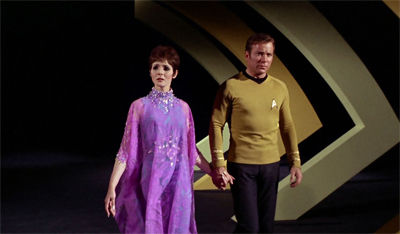
“Production budget? What production budget?”
As Mervyn Nicholson argues, there is a very clear aesthetic divide between the original Star Trek series and the live action series that would follow:
There is an obvious difference between Star Trek, the original show, and the successor series and movies. And that is that they look so different. In terms of the look, there is a definite dividing line between the origin and what came after. The first series looks primitive, even quaint — not much more than “a lot of orange paint [and] plastic plants” — by comparison with the successor series, with their sophisticated special effects and updated styling. The computers in the original series appear to be plywood painted grey. The revolution in special effects came after the first series, and affected both the movies and the TV series that succeeded it.
But the difference in style is much more than just special effects and, by the 1980s, changes in fashion and production values. The ’60s, the period of Star Trek, were long gone in a cultural sense, as well as in terms of visual fashions and production values. The original series has a definite look, a style. This look is not the mere consequence of what are today obsolete production techniques. By treating the style of the original series as integral to the show — and not as a kind of regrettable defect — we can get a better grasp on the Star Trek phenomenon itself. Typically, people talk about themes and characters, while the visual style is regarded with a patronizing sense of its quaintness. In fact, however, the look of Star Trek is deeply interesting in its own right.
The later series put a much greater emphasis on verisimilitude than the original Star Trek had, with the more abstract production design of episodes like The Thaw standing in stark contrast to the general look and feel.

They’re even vacuum-packed.
In some respects, it is interesting to wonder if the lack of detail on the sets of the original Star Trek simply reflected the reality of television production at the time. After all, television sets were a lot smaller during the middle decades of the twentieth century and broadcast reception was a lot rougher during the sixties. As such, set detail was a lot less important for sixties television shows than it would have been in later decades. Audiences at home were unlikely to be watching on sixty-inch high definition plasma television sets.
After all, a lot of the production design choices on Star Trek were made in the context of contemporary media technology. This is most obvious in the show’s use of colour. When Star Trek was first broadcast, colour television was a novelty. However, the show seemed designed for colour more than black-and-white. There was less emphasis on the sharp visual contrast associated with black-and-white cinematography, while the production design used all manner of bold and distinctive colour to give the series a unique visual flair.

Shadows and symbols.
In Inside Star Trek, Herb Solow argued that Star Trek benefited from its proud use of colour in its production design early in its first season:
However, in December 1966, with Star Trek having been on the air only three months, an NBC executive called with some news. The Nielsen research indicated that Star Trek was the highest-rated color series on television. I distributed the information to the Star Trek staff. We thought it was all very interesting, nothing to write home about, and went back to work. We were wrong; we failed to see the importance of the research.
Perhaps those initial and subsequent Nielsen color series ratings contributed to giving Star Trek a second year of life. Putting aside low national ratings and lack of sponsors, perhaps a reason for renewing Star Trek, other than all the phone calls, letters, and demonstrations at NBC, was its position as the top-rated color series on the ‘full color network.’ NBC’s parent company was RCA. Star Trek sold color television sets and made money for RCA.
Michael Kmet has suggested that this is something of an exaggeration, but it underscores how important colour was to the production design of Star Trek.

Talk about a black out.
This style of production design (heavy on strong colours and light on fine detail) was likely informed by the realities of contemporary television consumption. After all, television shows are designed to cater to the audience at home. This is not to diminish the fantastic work done by people like set designer Matt Jefferies, set decorator John Dwyer and cinematographer Jerry Finnerman. The fact that their work is still subject to so much discussion and debate today is a testament to their skill and technique.
The franchise wouldn’t begin moving away from this style of production until the third season of The Next Generation. The first two years of The Next Generation feature a number of studio sets that look and feel like they might have been lifted from the original Star Trek; the planets featured in Arsenal of Freedom, Skin of Evil or Loud as a Whisper. From the third season of The Next Generation onwards, dry ice and lighting was typically used to disguise studio-bound sets in episodes like The Enemy or Battle Lines.
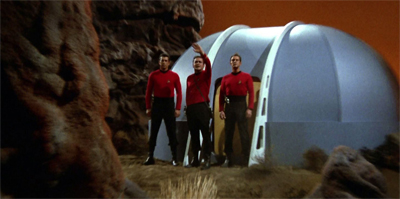
Getting away, Scott free.
Still, there is only so much that lighting and dry ice can do. Even on the later shows, the franchise’s fantastic (and famous) standing cave sets cannot perfectly emulate a real cave environment. On a science-fiction show like Star Trek, there is always some element of abstraction required. Given that this is a show with warp speed and transporters, suspension of disbelief comes with the territory. At the same time, even the cave sets in the later series would grow more elaborate and more detailed, more closely approximating real caves.
The set design in The Empath is simply the more abstract minimalist tendencies of the original Star Trek series taken to their logical extreme; sofas without furniture sets, consoles without walls, chains without ceiling hooks. It is haunting and unsettling, feeling incomplete. The set design in The Empath looks wrong on an instinctive level. The Empath wanders into the realm of the uncanny, suggesting that there something fundamentally broken. The set design is an artistic triumph.
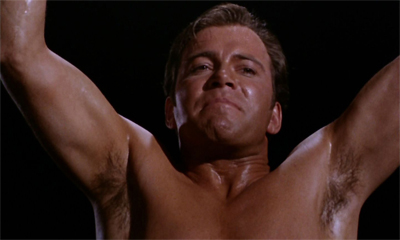
It was, by all accounts, a pretty rough season.
It also fits quite comfortably with the apocalyptic themes bubbling through the third season of the show. Star Trek was dead at this point in the run. There was very little that could change that. The series had been lucky to secure a third season; there would not be a fourth. It seems as though the entire production team has accepted this fact, a grim resignation sinking into every fibre of the production. There is a sense of dread that hangs over the whole of the third season.
To be fair, there were earlier points in the run when the universe seemed like a haunted place that was hostile to the very notion of humanoid life. The Man Trap had been the very first episode of Star Trek to broadcast, the story of a predatory salt vampire that was the very last of its kind on a dying world. It would be quite some time before Kirk encountered a rival galactic power, when the Romulans appeared in Balance of Terror. The Klingons would not appear until Errand of Mercy. Otherwise, space seemed strangely empty.

All set.
For most of the first season, the universe seemed to be inhabited by dead or dying civilisations that had shuffled off this plane of existence; the all-powerful aliens of Charlie X, the long-vanished “Old Ones” of What Are Little Girls Made Of?, Trelane’s parents in The Squire of Gothos, the Telosians featured in The Menegarie, Part I and The Menagerie, Part II. Although the universe became a bit more vibrant early in the second season, producer John Meredyth Lucas returned to that tone with episodes like The Immunity Syndrome or The Gamesters of Triskelion.
While the third season certainly mirrors that early portrayal of the Star Trek universe, it feels more melancholy. It is no longer that Kirk and his crew are wandering through the light of long-dead stars in search of ghosts, it is that Kirk is in the process of becoming a ghost himself. Death stalks Kirk and the Enterprise in the third season. The tone was set quite effectively in Spectre of the Gun, with Kirk and his away team sentenced to die in a shoot-out as they watch their final minutes tick away.
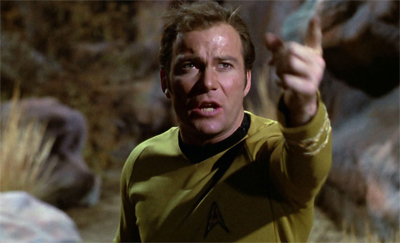
“I hate to point it out, but…”
Death accompanies Kirk as he warps across the universe, literally and figuratively. Kirk dies metaphorically at the start of The Paradise Syndrome, replaced by Kirok; later in that same episode, Kirok’s wife and unborn child are stoned to death. Spock fakes Kirk’s death in The Enterprise Incident. McCoy diagnoses his own terminal illness in For the World is Hollow and I Have Touched the Sky. Federation outposts seemed to be staffed by dead bodies in episodes like And the Children Shall Lead, Whom the Gods Destroy and The Lights of Zetar.
This apocalyptic tone simmers through The Empath, as Kirk and his away team visit a system that will soon be consumed by a star going nova. The Viians are engaged in fatal research, torturing their subjects to death. The Federation researchers are found dead, stuffed in labelled tubes. The Viians warn Kirk that their experiments will exact a deadly toll. “There is an eighty seven percent chance that the doctor will die,” Lal advises Kirk. What of Spock? “The possibility is ninety three percent that he will suffer brain damage, resulting in permanent insanity.”

Let it Viian.
Ultimately, the Viians are conducting an experiment to determine which civilisation will be permitted to survive the supernova. “Of all the planets of Minara, we have the power to transport the inhabitants of only one to safety,” Lal confesses. Even allowing for the relatively upbeat optimistic ending of The Empath in which all four participants survive the latest iteration of the Viians’ deadly experiments, the episode still ends with the deaths of an entire star system. (Save one planet.) Death stalks the Enterprise.
Still, The Empath is an endearingly optimistic episode. Star Trek is a show with an intrinsically optimistic perspective on the human condition. Although the franchise’s utopian idealism would not truly galvanise until the release of Star Trek: The Motion Picture, this was always a show about how humanity managed to survive the twentieth century and find their way out into the stars. In the context of the sixties, with looming threat of mutually assured destruction, that alone provided a counterpoint to post-apocalyptic science-fiction like Planet of the Apes.
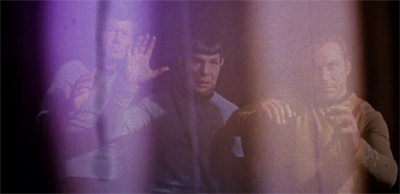
“Anybody up to recreate the poster for The Motion Picture?”
It is debatable how much of this utopian humanism was part of the franchise from the beginning. After all, Gene L. Coon was highly critical of the Federation as an institution in episodes like Arena or Errand of Mercy. It was only in the early years of The Next Generation that the franchise came to embrace the idea that humans were generally just the best at everything. This could occasionally become suffocating and overwhelming, particularly in episodes like Lonely Among Us or The Last Outpost or The Neutral Zone.
The Empath hits on a number of similar ideas, with the Viians abducting Kirk and his away team because they seek to exploit that which makes humanity special. However, The Empath is never as clumsy or awkward as those later episodes. In part, this is because the Viians suggest that humans are not inherently superior, and that they just happen to have developed values that are worthwhile and can thus serve as an example. This is also because the episode chooses to be very specific about what makes humans so special: empathy and compassion.
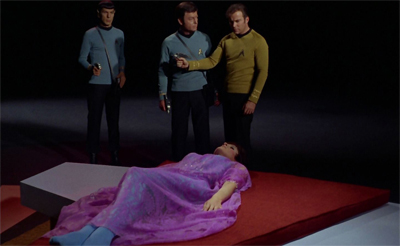
“I sense a Gem of an idea here.”
In keeping with the rest of the episode, this is a very simple idea. However, it is also very specific. Humanity are of interest to the Viians for a very precise reason. In fact, it seems to have been a happy coincidence that the Federation seemed to have a research post in the sector. Perhaps if another species had been present, the Viians might have used them instead. Indeed, Spock is just as capable of demonstrating the commitment and self-sacrifice which the Viians laud, with the episode never daring to suggest that Spock’s human half is superior to his Vulcan half.
(To be fair, there is some good-natured ribbing about Spock’s Vulcan heritage at the very end of the episode. “I find it fascinating that with all their scientific knowledge and advances, that it was good old-fashioned human emotion that they valued the most,” McCoy reflects. Scotty suggests, “Perhaps the Vulcans should hear about this.” Spock wrily responds, “I shall certainly give the thought all the consideration it is due.” However, Spock’s half-human heritage is never discussed, and he is just as willing to sacrifice himself to save Kirk and McCoy.)

Communicating his anxiety.
More than that, there is a sense that the humanism in The Empath is earned. In later Star Trek stories focusing on how special and unique humanity are, there is a sense that mankind is speaking from a position of comfort and luxury. It is easy for mankind to be selfless and altruistic in a world where the replicator can provide for just about every need, where poverty does not exist, and where the holodeck can allow individuals to live whatever life they choose. There is no conflict because technology has evolved to a point where it blunts the causes of conflict.
Watching later episodes of Star Trek, it can seem like the franchise embraces technological determinism. It can occasionally seem like mankind does not get along because they learned important lessons from history, mankind gets along because they invented magic technology. In a way, this aspect of the franchise’s utopianism feels quite cynical. After all, if the modern world does not have replicators or transporters, if it is not physically possible to eliminate poverty and starvation by pushing a button, can mankind really transcend its base impulses?

The brutality of the Viians really floored Kirk.
To be fair, it could be argued that there is some intrinsic worth to that sort of utopian thought. It is reassuring to know that all of our modern problems are transient, and that it is physically possible for mankind to get along with one another if all of our basic needs are met. However, it is also very much an easy answer with limited application to the modern world. It suggests that the problems with the world today have nothing to do with mankind, and everything to do with resource scarcity and competition.
This approach to utopian thought and idealism ignores the role that mankind plays in issues like food scarcity and poverty. It suggests that the problems facing mankind are all external, in a way that allows mankind “off the hook.” After all, what introspection and reflection is necessary if all it takes is a replicator to perfect mankind? If technology provides an easy answer, there is no need for personal development or growth to make a better world feasible. This is one of the big criticisms of Roddenberry’s utopian thought.
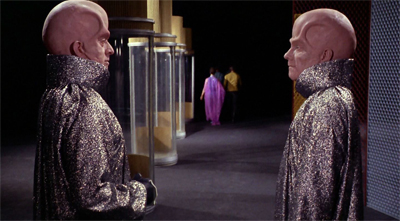
“Soon the Viians will have what we desperately need. Soon we will have the secret of William Shatner’s hairpiece.”
The humanism in The Empath is not anchored in technology. It is not an “easy” humanism preached to the universe by the crew of what is effectively a floating five-star hotel. Instead, the compassion and empathy in The Empath is well earned. It shines through a crucible of pain and suffering. Kirk’s compassion for Spock and McCoy is not diminished by the knowledge that he will suffer for the sacrifice that he makes, it is enriched by it. Spock’s willingness to sacrifice himself is even more altruistic once he knows the potential price of his sacrifice.
This is not the same as condoning the suffering or pain. The Empath is explicit in condemning of the Viians’ experiments. They may be a technologically advanced species, but their methods are barbaric. “You’ve lost the capacity to feel the emotions you brought Gem here to experience,” Kirk insists. “You don’t understand what it is to live. Love and compassion are dead in you. You’re nothing but intellect.” There is never any indication that the trials are “fair” or “justified” or “righteous”, even if they form something of a crucible for the crew’s humanism.

“Dammit, Jim. I asked them to tear my uniform sexy, just like yours.”
Indeed, the torture inflicted upon the crew in The Empath was so striking that it was the first episode of Star Trek not to be shown on the BBC. The British Broadcasting Corporation pulled the episode from its schedule. When fans wrote to query the show’s absence, the broadcaster responded in June 1976:
After very careful consideration a top level decision was made not to screen the episodes entitled Empath, Whom Gods Destroy, Plato’s Stepchildren and Miri, because they all dealt most unpleasantly with the already unpleasant subjects of madness, torture, sadism and disease. You will appreciate that account must be taken that out of Star Trek’s large and enthusiastic following, many are juveniles, no matter what time of day the series is put into the programme schedules. A further look has been taken following the recent correspondence, but I am afraid it has been impossible to revise the opinion not to show these episodes.
Reportedly, the controversy was sparked when the BBC’s broadcast of Miri in December 1970. The broadcaster reportedly received a high volume of complaints about content. As a result, The Empath, Whom Gods Destroy and Plato’s Stepchildren were not broadcast. They were first broadcast in the United Kingdom on Sky One in 1990.

No Miri illusion.
In some ways, the hard-earned humanism of The Empath foreshadows the approach that Star Trek: Deep Space Nine would take towards the franchise’s utopianism. The second live action spin-off would adopt a more skeptical approach to the technological determinism that defined a lot of the early Next Generation episodes, instead suggesting that mankind’s capacity for empathy and compassion is best judged under pressure or facing threat. Deep Space Nine would suggest that those virtues meant nothing if they could not survive a crucible.
The Empath is very much a piece of “pop Christianity.” To be fair, a lot of popular culture is heavily influenced by Christian belief. In the United States, and the larger western world, Christianity is treated very much as the default belief system. Even those raised outside Protestantism or Catholicism will recognise many of the basic stories, lending those tales a universal and recognisable quality. These core Christian stories are ubiquitous in western culture. As such, pop culture can seem to absorb these elements passively, almost through osmosis.
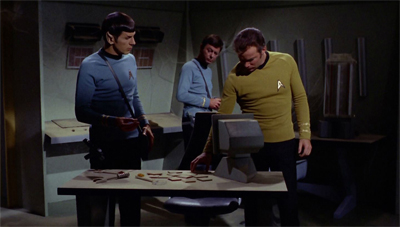
Research stations of the cross.
Certainly, the original Star Trek embraced a passive Christian aesthetic. In the later spin-offs, the Federation would be defined as an atheistic organisation that had moved away from religious and spiritual beliefs. However, episodes like Balance of Terror, Who Mourns for Adonais? and Bread and Circuses subtly seemed to suggest that the Federation shared the same religious outlook as sixties America; a monotheistic Christian belief system with chapels and a singular capital-g God.
The religious subtext in The Empath is distinct from those earlier stories. The episode is infused with Christian imagery and iconography, from the story itself through to the production design choices. The very idea of a representative chosen to suffer for the redemption of an entire species recalls the story of Jesus Christ. Like Jesus Christ, Gem takes the sins of the world upon herself. She even dies and is ultimately resurrected, saving her entire planet. The humanism at the heart of the story recalls a very New Testament philosophy of love and compassion.

A thorny issue.
Crucifix imagery abounds. The sofa on which Gem is sleeping evokes a cross. When Kirk and McCoy are tortured by the Viians, they are hung from the ceiling by chains that hold them in a position quite similar to the crucifixion. Gem’s miraculous healing powers recall those demonstrated by Jesus Christ, but it is worth noting the wounds that she takes upon herself. Early in the story, Kirk has a gash across his forehead; it recalls the wounds Christ would have suffered from the crown of thorns. Later, she heals his wrists, where the crucifixion nails would be.
The Empath is very much written in the style of a religious parable, something reinforced towards the climax of the story as Gem lays dying. When the Viians decide to take her away, they do not simply disappear as they did (repeatedly) earlier in the story. Instead, they float upwards, as if taking Gem towards heaven. The framing emphasise this ascent imagery, the camera inviting the audience to stare down at Kirk and the away team as the Viians ascend in their flowing gowns.

It’s all in the wrists.
While The Empath trades in Christian iconography, it never leans too heavily into it. Kirk and Spock never pause to label the story as one rooted exclusively in a western Christian tradition. Instead, the story incorporates the strong humanist values of the New Testament, recognising the ideas of empathy and compassion as intrinsically valuable without needing to tie them to a particular set of religious beliefs. It just so happens that the New Testament is one of the great humanist texts, so it makes sense to draw upon that imagery in crafting The Empath.
The Empath was the first and only episode of Star Trek to be directed by veteran television director John Erman. While Ralph Senensky’s work on Is There in Truth No Beauty? demonstrated the influence that a director could have on television production in the sixties, Erman’s experience on The Empath is perhaps more indicative of what sixties television shows expected from directors. There is a sense that television directors were largely treated as hired hands in the sixties, mostly in charge of getting the episode done on time and on budget.
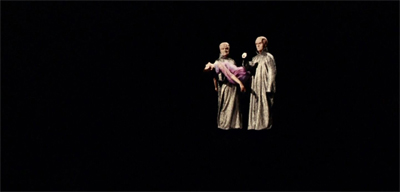
Just floating some ideas.
Discussing the episode with These Are the Voyages, Erman stressed that he had very little input into the stylised aesthetic of the episode:
My memory was that [the stylised approach] was pretty much dictated by the powers to be. I don’t think I had a whole lot to say about it. The only place that I kind of exerted some influence was with Kathy Hays and a couple of the other actors, but I didn’t have control over what the look was supposed to be.
Erman was largely working within predefined boundaries established by the production team, rather than defining his own vision of what he wanted Star Trek to be.

The production team had to find new and exciting ways to keep William Shatner and Leonard Nimoy from killing one another.
In many ways, Erman seemed to be there to mediate between the various actors and their competing interests. William Shatner and Leonard Nimoy had a strained relationship at this point in the run of the original Star Trek show. Both actors had a legitimate claim to playing the lead character. William Shatner was top billed and played the senior officer, while Leonard Nimoy was very much the breakout fan-favourite character who received mountains of fan mail each and every week.
With all of that in mind, it was inevitable that there would be some tension between the two performers. Both Gene Roddenberry and Fred Freiberger had been forced to carefully navigate the egos of the two leading men, with the show often caught between their demands. William Shatner would notoriously count his lines in a given script and steal lines from his co-stars. Leonard Nimoy had been embroiled in a heated salary battle at the start of the second season, seeking to increase his input and influence over the show.

“Well, at least I don’t have to count her lines.”
The directors of individual episodes could often find themselves caught in the middle of this tug of war between the two actors. In Science Fiction Television Series, co-star Alan Bergmann recalled working on The Empath:
Working with Ms. Hays was a pleasure. Mr. Shatner and Mr. Nimoy seemed to be in conflict. They struggled over better camera positions and made life difficult for the director.
After all, as far as Shatner and Nimoy were concerned, the episodic directors were just blow-ins who were working on the series for a single episode. Erman must have seemed like easy prey to Shatner and Nimoy.
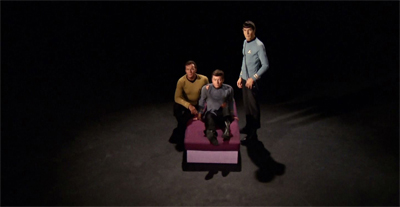
Things are looking up.
Discussing the experience with Marc Cushman for These Are the Voyages, Erman candidly acknowledged a sense of disappointment with how he was treated by the show’s two lead performers:
I just remember that I was really disappointed in Lenny. I had known him from before when we were both young actors. We had studied with Jeff Corey at the same time, and so I was really looking forward yo doing the show. But the role of an episodic director is not a very creative one. I likened it, at one point, to saying that you’re kind of sweeping the sh!t under the carpet. You’re not really able to make creative choices. The only time you’re really creative in episodic television is if you do the pilot, or if you come in right after the pilot. But nobody was like Bill and Lenny. I don’t remember any other actors absolutely saying what those guys said, which was, “Oh no, my character just wouldn’t do that.” That was kind of the ultimate put down [for a director].
Erman is quite honest in discussing the role of a director on a show like Star Trek, as something akin to a safe pair of hands. He is also quite frank in his assessment of the two lead actors.
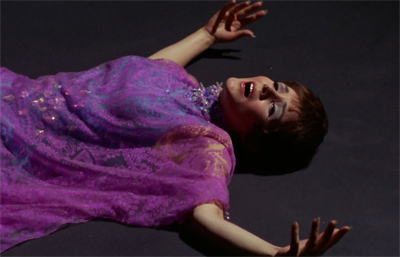
This one’s a real Gem.
Still, beyond the difficulties facing Erman in dealing with Shatner and Nimoy, The Empath is a very effective and very intriguing piece of Star Trek. It is an episode that is striking and memorable, as much for its simplicity as for anything else. It is an episode that cuts to the heart of the franchise’s humanist and idealistic philosophy, without feeling heavy-handed or awkward. It is a piece of pop Christian television that never feels patronising or crass. The Empath is a remarkable accomplishment, all the more powerful for how surreal and odd it seems.
Then again, it is perhaps the perfect third season episode.
Filed under: The Original Series | Tagged: compassion, humanism, star trek, the empath, utopianism |




















‘The Empath’ is a fine and moving piece of work. All concerned should be very proud of what they accomplished.
It really is. Massively underrated.
Strange that in all this write-up you mentioned Kelly but briefly though in many ways this is his episode.
I thought that as well, this was very clearly a McCoy episode, with him making the ultimate sacrifice for Spock and Kirk, and mentioning him so little in the review feels like a great disservice.